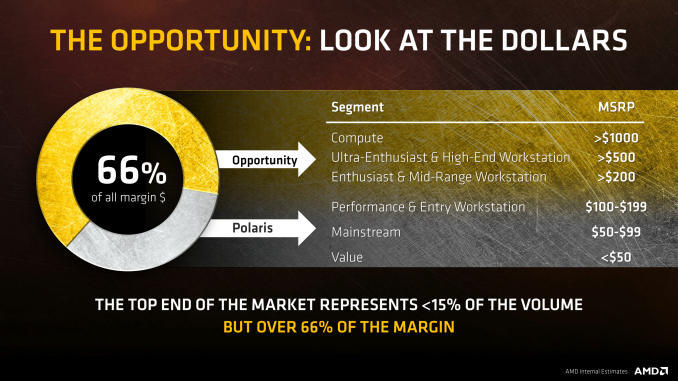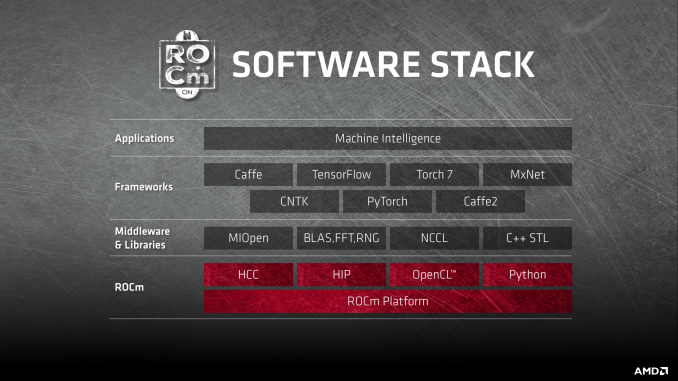AMD Unveils the Radeon Vega Frontier Edition: Vega Starts in the Pros
by Ryan Smith on May 17, 2017 2:45 AM EST- Posted in
- GPUs
- AMD
- Radeon
- Machine Learning
- Vega
- Radeon Pro
- Vega Frontier Edition
Vega Frontier Edition’s Target Market: AI, Machine Learning, and other Professionals
As important as the Vega hardware itself is, for AMD the target market for the hardware is equally important if not more. Vega’s the first new high-end GPU from the company in two years, and it comes at a time when GPU sales are booming.
Advances in machine learning have made GPUs the hottest computational peripheral since the x87 floating point co-processor, and unfortunately for AMD, they’ve largely missed the boat on this. Competitor NVIDIA has vastly grown their datacenter business over just the last year on the back of machine learning, thanks in large part to the task-optimized capabilities of the Pascal architecture. And most importantly of all, these machine learning accelerators have been highly profitable, fetching high margins even when the cards are readily available.
For AMD then, Vega is their chance to finally break into the machine learning market in a big way. The GPU isn’t just a high-end competitor, but it offers high performance FP16 and INT8 modes that earlier AMD GPU architectures lacked, and those modes are in turn immensely beneficial to machine learning performance. As a result, for the Vega Frontier Edition launch, AMD is taking a page from the NVIDIA playbook: rather than starting off the Vega generation with consumer cards, they’re going to launch with professional cards for the workstation market.
To be sure, the Radeon Vega Frontier Edition is not officially branded as a Pro or WX series card. But in terms of AMD’s target market, it’s unambiguously a professional card. The product page is hosted on the pro graphics section of AMD’s website, the marketing material is all about professional uses, and AMD even goes so far as to tell gamers to hold off for cheaper gaming cards later on in their official blog post. Consequently the Vega FE is about the closest analogue AMD has to NVIDIA’s Titan series cards, which although are gaming capable, in the last generation they have become almost exclusively professional focused.
AMD launching a new GPU architecture in the professional space first is a very big deal. Simply put, the company has never done it before. Fiji, Hawaii, Tahiti, Cayman, Cypress, and more all launched in consumer cards first. The traditional wisdom here is that launching in the consumer space first allows consumers to get their hands on the cards now, while professional products undergo further validation and refinement to meet the higher standards of professional users. Put another way, consumers serve as the final layer of debugging a new GPU, offering mass testing unlike anything else. So for AMD to launch in the pro market first indicates that they have an extensive amount of faith in the product.
As for why AMD would want to do this, the following AMD slide says it all.
Simply put, professional cards sell for higher prices than consumer gaming cards, sometimes significantly higher. As a result it makes all the sense in the world to sell their first Vega cards to professional users who are willing to pay $1000+ for a compute card, as opposed to consumers who would like to pay half that. More than anything else, AMD’s overall lack of profitability has come from a lack of high-margin parts to help offset their ongoing operational costs, and launching Vega as a pro card is one of the steps AMD is taking to correct that.
For pro users then with sufficiently deep pockets, they’ll be the first to get a crack at AMD’s latest high-end video card/accelerator. AMD calls this line of cards the Frontier Edition, and while the name is clearly AMD being cheeky towards NVIDIA’s Founder’s Edition line, the analogy isn’t completely off-base. AMD’s target market is going to be machine learning developers, game developers, and others who AMD believes need early access to the cards for future development. The advantage of this route is that, particularly in the case of machine learning, this allows developers to get a jump on testing a new architecture ahead of placing a large order for server cards. So in a sense, one of the roles of the Vega FE is to prime the pump for selling Radeon Instinct MI25 cards later in the year.
As for consumers, while this is as big a change for them as it is for AMD, it’s likely a hallmark of what to expect in the future for new high-end GPU launches. For AMD gamers who have been holding out for Vega, it’s clear that they’ll have to hold out a bit longer. AMD is developing traditional consumer gaming cards as well, but by asking gamers to hold off a little while longer when the Vega FE already isn’t launching until late June, AMD is signaling that we shouldn’t be expecting consumer cards until the second half of the year.
Wrapping things up, it’ll be very interesting to see how this strategy goes for AMD. NVIDIA has been very successful in the machine learning market over the last year, and if AMD can replicate NVIDIA’s success, not only will they make the machine learning market far more competitive for everyone, but they also stand a very good chance of finally turning the corner on both profitability and their overall share of the HPC market.













134 Comments
View All Comments
rocky12345 - Wednesday, May 17, 2017 - link
So this all good and all but are we to assume the consumer vega will have less of everything. I mean if this thing is on par or slightly faster or slower than Titan Xp what do we expect from the consumer version then.Yojimbo - Wednesday, May 17, 2017 - link
It depends on yields. It depends if this Frontier product is a show product or a viable production product with reasonable volume. It's possible the high-end consumer Vega will have the same number of cores and the same clock frequency, but with 8 GB of VRAM instead of 16.peevee - Wednesday, May 17, 2017 - link
I have two questions based on the article:1. "NVIDIA has been very successful in the machine learning market over the last year, and if AMD can replicate NVIDIA’s success, not only will they make the machine learning market far more competitive for everyone"
How big is the market compared to pro and consumer graphic card markets?
2. Can you compare the specs not just to previous AMD cards but also to Nvidia, both Pascal and Volta?
peevee - Wednesday, May 17, 2017 - link
3. What is the FP64 performance? What is INT8 performance?tuxRoller - Wednesday, May 17, 2017 - link
This is the prettiest card i can recall.It has a very Google aesthetic.
tuxRoller - Wednesday, May 17, 2017 - link
Regarding Google, they seem to have announced a bit of a coup with their tpu2. Not only is it faster, and more scalable but it can also now be used to train your network.I'll be very curious as to how serious Google becomes with this hardware. The combination of their massive r&d budget, personnel, infrastructure, and interests place then in an enviable position.
Meteor2 - Wednesday, May 17, 2017 - link
Yeah but you can't buy TPUs, only access to them (via Google Compute). I can't believe that will be very popular (or cheap).tuxRoller - Wednesday, May 17, 2017 - link
I never said you could, and none of these products (including the recently unbelief volta card) are going to be selling high volumes. That's why i think calling them competitors with Nvidia (as someone in this section did when mentioning Nvidia's volta tensor units) doesn't make sense. The tpus are an advantage for Google's services in the same way their infrastructure "ip" is.For the companies that would be interested in tpus, the price isn't as important as the performance. That's why Nvidia can charge 16k for a card.
Google isn't going to sell these, but someone will because you just don't need all the isa overhead that gpgpus have. It's the classic asic advantage that isn't going to go away for a while (their disadvantage is the one you've what mentioned).
Yojimbo - Thursday, May 18, 2017 - link
It's unclear how much more powerful or power efficient the TPU2 is than Volta. What's clear is that it's far less flexible. Unlike a GPU, a TPU only works with TensorFlow networks, from what I understand. It doesn't seem to give the option of quantization of networks, unlike Volta.Most importantly, I think most machine learning will be used in conjunction with analytics, simulation, or visualization. Software is being developed that will allow GPUs to process all those applications (machine learning training, machine learning inferencing, analytics, simulations, and visualization) from common data structures. In such cases, by using GPUs, data will be able to be processed with one architecture and without needing to spend the time and power to move them around to do it.
If the goal is to apply machine learning and only machine learning to a problem, the TPU may be preferable. But if the data should also be processed in other ways, it will probably make more sense to use a GPU.
tuxRoller - Thursday, May 18, 2017 - link
What point of mine are you arguing about?If volta was a better fit for them they wouldn't have needed to create their own asic. That it is an asic is part of the reason why it is more efficient (ops/W, ops/s, ops/mm², or it's simply more scalable as their nodes seem to indicate).
Also, these new tpus appear to be vastly different from the first gen given that it is end to end sp.
Btw, I'm not saying that Google is going to put Nvidia out of business. As I've said, they aren't even competitors right now. So, you don't need to defend the honor of Nvidia to me:)